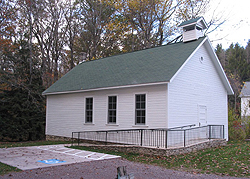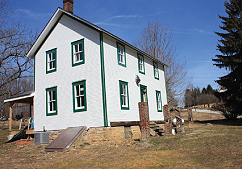Two Historic Buildings Find New Life in Fallingwater’s Educational Programs

The nearly century-old Bear Run Schoolhouse, which is now the Bear Run Educational Center, houses many of Fallingwater’s ongoing programs. The Western Pennsylvania Conservancy restored the historically significant building in 2010.
Just outside of the entrance to Fallingwater stands a crisp, white-sided, one-room schoolhouse with an Aspen-green roof. Inside, historic-looking light fixtures with milk glass shades hang from the ceiling, a dark-gray chalkboard is mounted on the building’s white, beadboard-paneled interior walls and simple roller shades cover the windows. If it weren’t for the LCD projector, stand and screen, a visitor might think the Bear Run School had not been disturbed since it was first built in 1904.
The Western Pennsylvania Conservancy restored the building, which has experienced a few incarnations, and returned it to its original schoolhouse state. It is now the Bear Run Educational Center and its present-day students are children and adults who participate in Fallingwater’s ongoing educational programs.
The educational center is one of two historically significant buildings that recently have undergone renovations and found new lives in Fallingwater’s educational programs. Less than 600 feet away from the schoolhouse sits the Ohler house, which housed Fallingwater’s interns for the first time last summer.

The Western Pennsylvania Conservancy now uses the Ohler home as housing for interns.
Few visitors know before they visit Frank Lloyd Wright’s masterwork that Bear Run was once a thriving community with a logging operation and small-scale clay and coal mines. It was a stop along the Baltimore and Ohio Railroad and a destination for owners of nearby farms and vacationers from Pittsburgh.
The Bear Run School sits along present-day Route 381, near the current Fallingwater entrance. The community originally built the schoolhouse nearly a century ago, together with a butcher shop, a blacksmith shop and other necessities.
The community dwindled and the Kaufmann family acquired the building in the 1950s. They converted the school into housing for employees by dividing the one room plan into bedrooms a bathroom and the addition of a garage. More recently, Fallingwater had been using the school for offices and storage.
The Conservancy began the schoolhouse renovation in 2010, with the aim that the building would eventually be converted back to a one-room schoolhouse dedicated to supporting educational activities at Fallingwater.
The project began with the removal of the Kaufmann’s 1950s modifications. Workers rewired the building’s electric, hung new drywall, refinished the hardwood floors and made other improvements to the interior.
During the project, WPC found evidence the schoolhouse once had a bell tower and a bell that had disappeared over the years. Organizers of the renovation looked at other one-room schools in the area and recreated a tower based on the research. When community residents heard about restoration project, they came forward with the original bell, which the Conservancy hung in the tower.
Now the school is handicap accessible, with an entrance ramp and parking. The newly renovated, now-air-conditioned structure includes a restroom, a kitchen and a classroom with updated educational equipment. Generous grants from the Double Eagle Foundation made the improvements possible.
Further north on Mill Run Road sits the Ohler Farmstead and the Ohler house, which the Conservancy acquired in 1989. Adam Ohler and Eberharter Shipley built the farmhouse between 1910 and 1920. According to the Library of Congress, the farmstead is notable because it’s a great example of the type of construction and the subsistence farms that existed in the Bear Run community during the Industrial Period.
Adam Ohler’s son, Herbert Ohler, was the caretaker of Fallingwater during the 1930s.
The house is now white with neatly painted green trim and has found a new life as living quarters for the Fallingwater interns.
